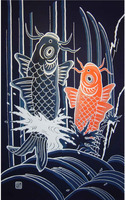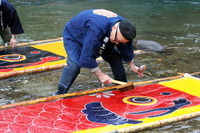

Total:131items
- Pottery & Porcelain (18)
- Lacquerware (4)
- Glasswork (2)
- Wood & Bamboo Work (19)
- Leather Work (1)
- Papermaking (13)
- Textile (20)
- Dyeing products (5)
- Masonry (1)
- Metal Work (11)
- Stationery (4)
- Livingware (3)
- Accessory (4)
- Toys & Entertainment (14)
- Interior (2)
- Other crafts (10)

 |
Main Production Site:Gifu |
 《Characteristics》
《Characteristics》"Gujo-Honzome", a gift from natural Indigo plants, is characterized by its dark indigo-blue produced by the elaborately repeated dyeing processes. The indigo-dyeing fabrics are made by soaking cloths some dozen times into a dye made from fermented indigo leaf balls matured with wood ash, lime and wheat gluten in a pot embedded on an earthen floor. Its laborious dyeing method has been handed down since the Edo period (17-19c).
The insect repellent quality of Gujo indigo dye is also applied to 'furoshiki' (wrapping cloth), which has been used to protect silk kimono from being moth-eaten since ancient times.
The longer you use, the more you will appreciate the values of "Gujo dyeing". There are other unique products in Gujo Honzome, such as "Koi-nobori (carp streamers)". Those large works are washed in the river and stretched and dried outside after dyeing.
The craftwork of Gujo dyeing has been taken over for about 430 years in the submontane castle town of Gujo Hachiman. Gujo Honzome products were recognized by people through their daily use of the products. Consequently, it was designated as Important Intangible Cultural Property of Gifu prefecture in 1979.
[Important Intangible Cultural Property of Gifu prefecture)
Information provided by Watanabe Dyehouse of Gujo Honzome
Translation by: Naoko Yamashita, reviewed by Tomoko Yamamoto

| Materials | Cloth, Indigo plant, Starch made of mashed rice cake |
|---|---|
| Crafting Processes | There are two types of "Gujo Honzome" ;
1. "Aizome (Indigo dyeing)" 2. "Kachin-dyeing (stencil dyeing)" for Koinobori (Carp streamers) 1. "Ai zome" (Indigo Dyeing) "Ai-zome" or indigo dyeing is a traditional dyeing method passed down since a long time ago. Indigo dye is made from raw leaf balls of indigo plants matured after being mixed and fermented with lye extracted from wood ash in an earthenware pot buried on an earthen floor. Fabric is soaked into the dye again and again into deep indigo blue. 2. Carp Streamer (Kachin-Dyeing or stencil dyeing) Kachin-dyeing (stencil dyeing) applied to Koinobori (carp streamers) uses squeezed soybean juice. Stretched white cotton fabric is fixed onto bamboo frames with strings and a design is outlined on it by hand with rice cake paste which resists the indigo dye. After rice cake paste dries, The design is colored using a special dye with squeezed soybean juice added.The rice cake paste on the outline is washed away in the running river two or more days after coloring. Process of washing "Koi-nobori" in the river is called "Kan-zarashi", which means exposing fabric in cold water. This process makes the dye fixed and bright on the fabric as well as increases the fabric's durability. [Traditional dyeing method] "Tsutsugaki" is a drawing technique used in both indigo dyeing and stencil dyeing. Tsutsugaki method, which is handed over since many years ago, is a hand drawing method. Finely kneaded paste is put into a tube, and a design or a pattern is hand-drawn on the fabric directly with the tube. After the paste is dried, the fabric is soaked repeatedly into the indigo dye in the earthenware pot and the washing and drying processes are repeated until perfect indigo blue comes out on the fabric. Excellent hand-drawing skills can be imagined on the excellent work. Koinobori (carp streamers) is also made by the Tsutsu-gaki method. After Koinobori is hand-drawn on a fabric directly with the tube, squeezed soybean juice ('gojiru') is added to the dye and the design is repeatedly colored with a brush in the dye. |
| History | The origin of Gujo Dyeing is said to date back to the Tensho era, just before the Edo period (17-19c). Its history of 430 years still continues and the unique dyeing method has been taken over to date in Gifu prefecture. However the method had no name until it was named "Gujo Honzome" in 1960's.
Indigo was used as a natural dye since ancient times. In the Edo period (17-19c), it was known that the insect-repelling substance comes out from indigo-dyed fabrics, so ordinary people used indigo fabrics for their daily clothing and even for other purposes: from working wears for farmers and firemen to festival Happi. But especially, indigo dyeing was useful for furoshiki (wrapping cloth) to protect expensive silk kimono from being moth-eaten. In Japan, until the Taisho period (1912-26), there used to be more indigo workshops in Gujo Hachiman than in other regions, and seventeen workshops existed in the early Showa period (20c). Now only one traditional dyehouse remains and natural indigo dye extracted from indigo plants is shifting to chemical indigo dye. Traditional culture and craftworks handed down through centuries are being replaced by convenient and reasonable products. Such trend wiped out dyehouses in Gujo Hachiman except the Watanabe family that preserves the elaborate dyeing tradition even today. |
| Related URL | http://www.gujozome.jp/ |
◆Exhibition / Showcase
Gujo Honzome Watanabe Dyehouse
Address: 737 Shimadani, Hachiman-cho, Gujo City, Gifu Prefecture 501-5222
Tel: +81-(0) 575-65-3959 Fax: +81-(0) 575-65-3958
(Japanese only)
◆Event Information
"Koinobori-no-Kanzarashi" (The seasonal event of rinsing carp streamers)
On the day of Daikan (大寒) , January 20th every year, "Koinobori-no-Kanzarashi (the seasonal event of washing carp streamers)" is held in limpid water of the Yoshida river in Gujo-Hachiman area. Carp streamers, dyed with "Kachin-zome (stencil dyeing)" method of Gujo-Honzome, are washed in the cold water to remove the paste used for carp streamer designs. This process of washing the fabrics in the cold water with removing the paste tightens the fabric and creates bright colors on it. Furthermore, the process enhances durability of the fabric.
"Kanzarashi" that has been passed down since the Edo period (17-19c) is an event to wish children's healthy growth. Lots of people inside and outside of Gifu prefecture come to see this traditional event in winter.
Koinobori-no-Kanzarashi Event Information
Assistance needed? For inquiries in English:
JTCO Contact Form
Your inquiries will be forwarded by JTCO in Japanese to the organization you wish to contact.



